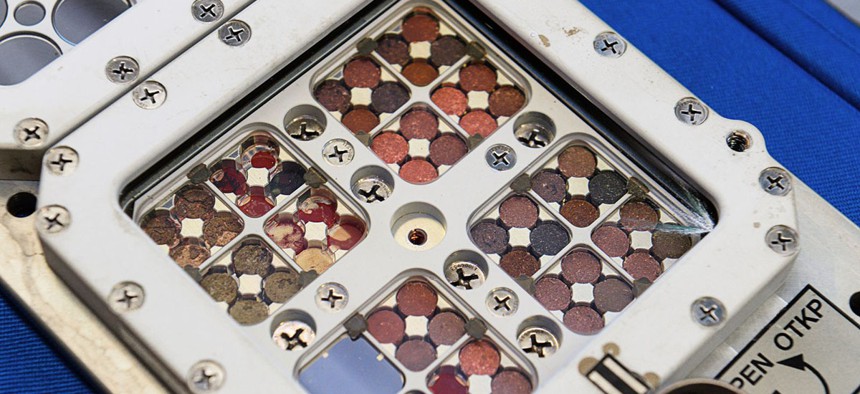An Algae That Survived Two Years in Outer Space May Hold the Secret to Growing Food on Mars

The algae samples aboard the ISS. DLR
Algae produce proteins and oxygen, both key ingredients for surviving once humans leave the blue planet.
Humans won’t survive on Mars for very long if they don’t learn to grow their own food. That’s why we need to answer the question: What, if anything, can grow on the red planet?
A two-year experiment on the International Space Station (ISS) gives us some hints. A species of green algae and photosynthesizing bacteria have survived their 450-day stay in outer space. All but one of the algae samples started growing after being returned to Earth.
The experiment was part of the Biology and Mars Experiment (BIOMEX) to understand to what extent terrestrial life can survive in space. It involved a series of pockets where hundreds of specimens of bacteria, fungi, lichens, algae, and mosses were exposed to conditions of near vacuum, temperatures between -4 °F (-20 °C) and 116 °F (47 °C), and a continuous blast of ultraviolet radiation.

The BIOMEX lab was sent back to Earth in June 2016, and we are starting to get the results. Researchers are now analyzing the DNA of what survived to look for what kind of damage it may have suffered.
The surviving algae belonged to the Sphaerocystis species, found in Svalbard, a Norwegian archipelago, and the cyanobacteria to the Nostoc species, found in Antarctica. The species were selected because they are known to withstand extreme cold. The algae species protects itself by entering a dormant state, forming thick walls and orange cysts rich in cartenoids, which is the chemical that gives carrots its color and is known to be protective against radiation. These two species are now being added to the small but growing list of terrestrial organisms that can survive space, which include lichens, bacteria, and water bears (tardigrades).
A practical lesson from these survivalists could help us farm on Mars. Algae produce proteins and oxygen, both key ingredients for surviving once humans leave the blue planet.
The survivors could also help us understand how life on Earth began. The leading hypothesis is that life emerged spontaneously from just the right mix of chemicals and environmental conditions, but there is also the possibility that it may have been delivered to Earth by meteorites or comets. Such life would have needed to survive harsh conditions of space en route, which is why the BIOMEX results support the hypothesis.


